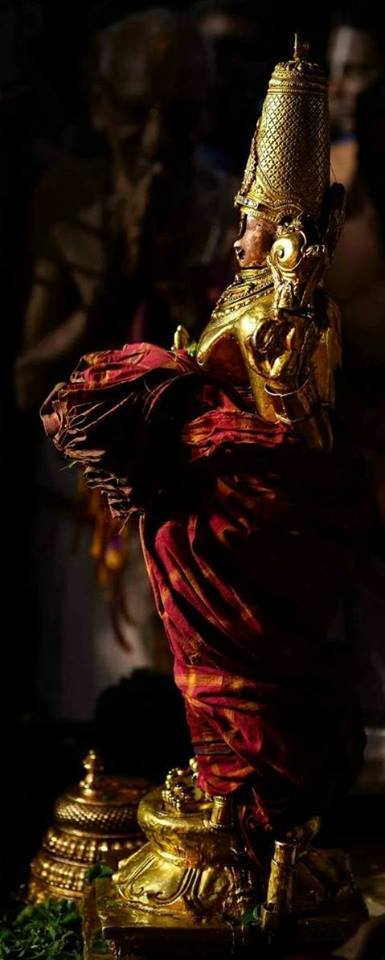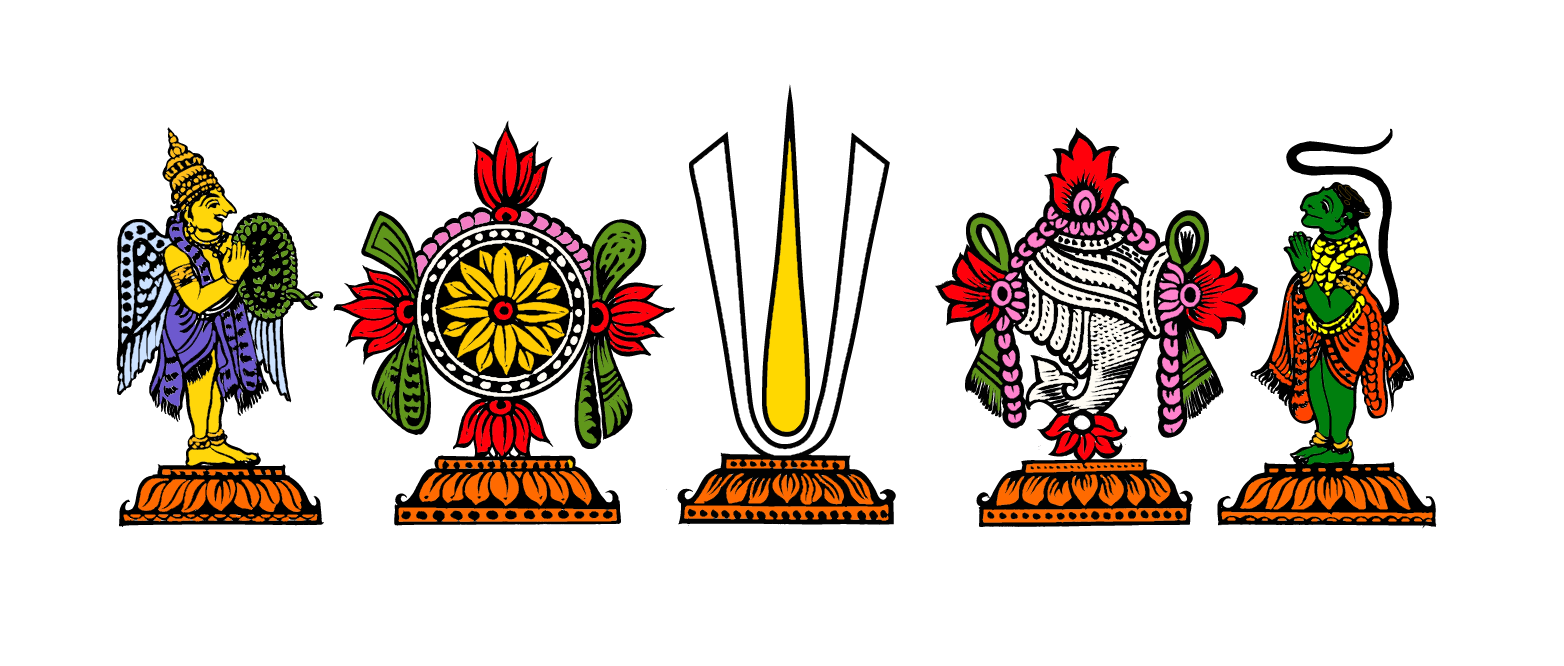
Our Scriptures
[Excerpts from a paper presented by a disciple of Srimad Andavan at the Fifth Annual Vaishnava-Christian Dialogue, Chennai, 17 December 2019]
Ubhaya Vedanta
The roots of the Srivaishnava tradition can be traced back to the ancient Sanskrit texts of the Vedas and the Pancharatras. The simplified essence of the Vedas was revealed later in Tamil by twelve vaishnavite saints, the azhwars, through their compositions called the Divya-prabandhams.
The syncretic fusion of these two traditions from the Sanskrit Veda and the Tamil Divya-prrabandham is often referred to as ubhaya-vedanta, or the dual vedanta. Tradition attributes the revival of Srivaishnavism to Nathamuni in the 9th century CE, while Ramanuja structured the core philosophy of Vishishtadvaita or qualified monism by writing elaborate commentaries on the Brahma-sutras and the Bhagavad-gita in the 11th century CE.
Divyaprabandhas
The word Azhwar refers to those who were immersed deeply in love of God. Their songs of rapture were outpourings of intoxicated divine love, and are collectively known as the Nalyira Divya-prabandham or the ‘four thousand verses of divine composition’. These verses form the preliminary foundation of prapatti literature and theology.
As Nammazhwar, the foremost of the twelve azhwars says in the Thiruvaymozhi: “You are the Lord of all the three worlds, and at Your divine feet, this vassal squarely takes refuge, with no other hold.”
In Thiruvaimozhi, Nammazhwar sings about his full awareness of the bond existing between him and the Supreme Lord, who is the father of all creations, and does not expect anything except unconditional love from the aspirant.
Prapatti only reiterates the filial bond which exists between aspirant and the God, whose grace is there for all, like a mother’s selfless love for her child. What is required from the aspirant is constant remembrance and supreme faith in God’s grace. Nammazhwar’s most important insights into the nature of reality, and the relationship between the divine and the human became foundation stones for the later Srivaishnava community.
The works of the azhwars were collected, codified and consolidated by Sriman Nathamuni in the 9th Century CE. He divided the Divya-prabandhams into four parts: Mudalayiram, Periya Thirumozhi, lyarpa and Thiruvaymozhi.

Writings of SrI vaishnava acharyas
The philosophical construct of Srivaishnavism which taught that prapatti is the easiest and quickest means to salvation, was elaborated by many stalwart acharyas such as Srimad Yamunacharya, Bhagavad Ramanuja and Srimad Vedanta Desika.
After Nathamuni, it was Yamuna, his grandson, who systematically introduced the doctrine of self-surrender through works such as the Stotra Ratna, where he explains that the path of loving self-surrender or sharanagati is open for one who is unable to follow the path of action or karmayoga, the path of knowledge or jnanayoga and the path of devotional love or bhaktiyoga, and thus has no other way of salvation. In the Stotra-ratna, Yamuna therefore seeks protection from the Lord in a state of complete helplessness and total dependence, and declares that the Lord is his only refuge.
Ramanuja whose Sharanagati Gadyam is an exposition and expansion of the philosophy of prapatti penned by Yamuna in the Stotra-ratna, introduces a ritualized version of prapatti that specifically addresses those who are ineligible for practicing the different kinds of yogas. Srivaishnavism thus offered a soteriology that included everyone who was incapable of Vedic study through birth or qualification, or those who were mired in illusory entanglements, and could not extricate themselves from a life of sin.
Srivatsya Varada Guru, a twelfth century preceptor, known popularly as Nadadoor Ammal in his Prapanna-parijata explains that prapatti is not a new concept but has its roots in the Vedas. The vasuranya mantra of the Taittiriya section of the Krishna Yajurveda mentions prapatti by the name ‘nyasa’, the act of giving oneself up to the Lord, and also describes the procedure for performing prapatti.
An often quoted definition of prapatti composed by Nadadoor Ammal in the Parijata is a fervent plea to the Lord, where he says: “I am the abode of all sins, utterly helpless and without any other recourse. O Lord! You alone are my means to salvation! Such a condition of the mind is called prapatti.”
In the post-Ramanuja period, many of his immediate successors produced a vast range of prapatti literature in Sanskrit, Tamil and Manipravala. They usually took the form of praise-forms or stotras, elaborate commentaries or vyakhyanams and poetic-epics or maha-kavyams. There are over forty commentaries on the Nalayira Divya-prabandham alone, with a vast ocean of other literature on prapatti that has been composed since then.
Amongst Ramnuja’s successors, it was Vedanta Desika who emerged as the greatest guardian and proponent of Sri Vaishnavism through his elaborate commentaries and compositions that enshrine the significance of prapatti in all its aspects. The primary book in which he has elaborated the deeper internal mysteries of prapatti is the ‘Rahasyatrayasara’. He has also independently established the supremacy of prapatti through other compositions in Sanskrit and Tamil such as Tatparya-tika, Gitasara, Nyasa-vimshati, Nyasa-tilaka, Nyasa-dashakam, Nikseparaksha and Adaikkalappattu. Further, Vedanta Desika analyses the Saranagati Gadyam of Ramanuja by comparing the verses with each word of the three great Sri Vaishnava mantras: the mulamantra, the dvayam and the charamasloka.
We can see therefore that the literature of prapatti was available before Sri Vedanta Desika in a cryptic form. However, it was Vedanta Desika who elaborated, reaffirmed, consolidated and simplified the doctrinal tenets of prapatti. He points to reassurances given by the Supreme Lord to the surrendered jiva: when the jiva is in despair or grief because he is not able to adopt certain upayas or methods which are prescribed as productive for one’s salvation, then the Lord promises to stand up as those upayas and guarantee the result of salvation.
Main canonical scriptures that are studied by Srivaishnava students
Although there are many books and texts studied by ardent followers of Srivaishnavism, the main four bodies of canonical literature that need to be studied are:
01 — Rahasya-traya Saram
Written by Srimad Vedanta Desikan to reveal the inner mysteries and esoteric truths of the three great mantras of Sri Vaishnavism
02 — Bhagavad-vishayam
A commentary on the Thiruvaymozhi of Nammazhwar, originally written by Thirukurugai Pillan, and called the Arayirapadi. Subsequently, there have been other commentaries too.
03 — Gita Bhashyam
A commentary on the Bhgavad-gita by Bhagavad Ramanuja
04 — Sri Bhashyam
Bhagavad Ramanuja’s elaborate commentary on the Brahma Sutra of Bodhayana that lays the foundational tenets of vishistadvaita, the philosophical construct of Sri Vaishnavism.

